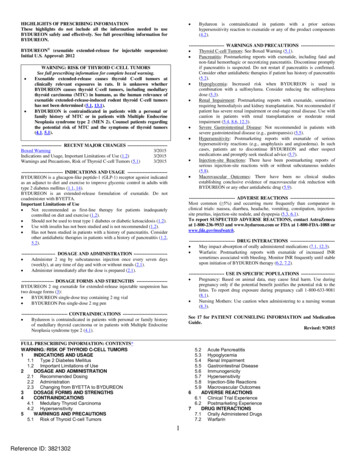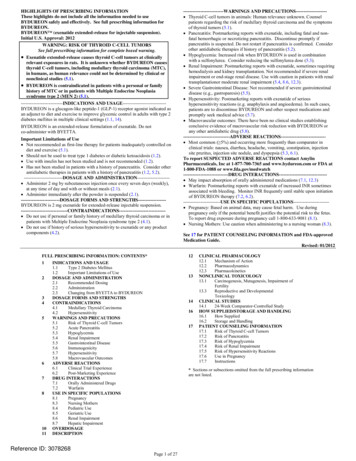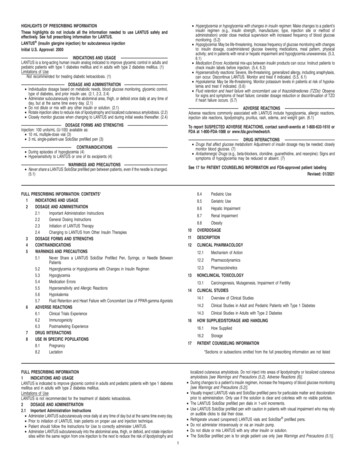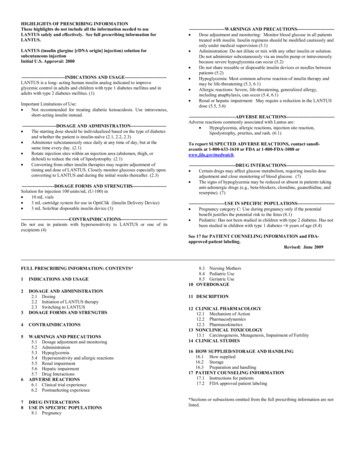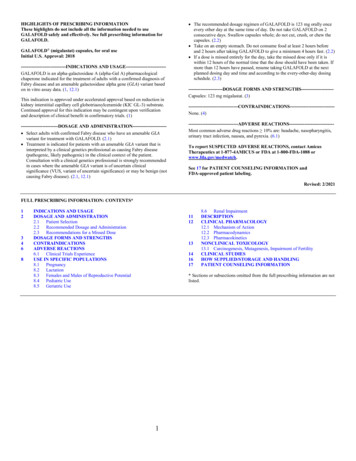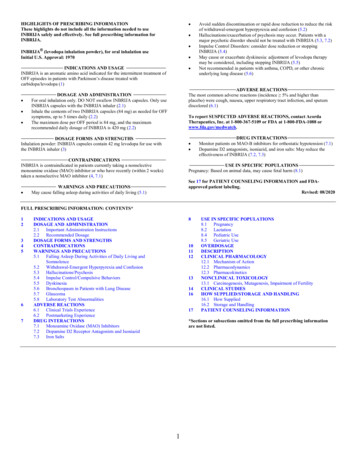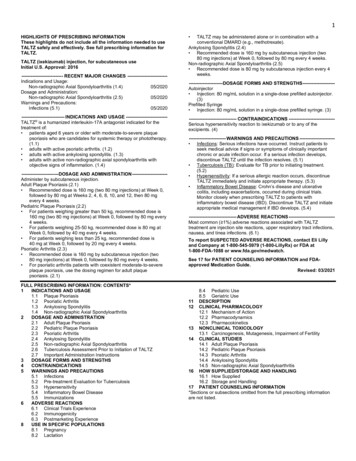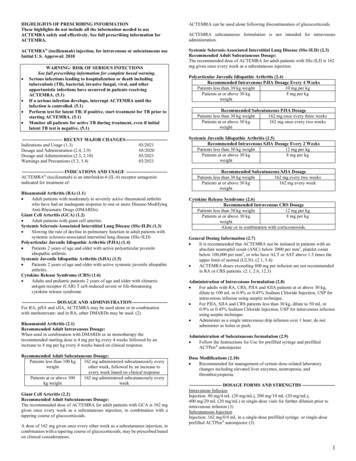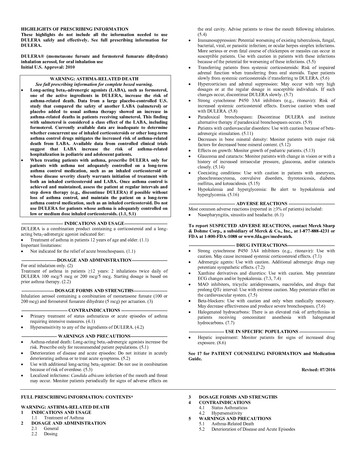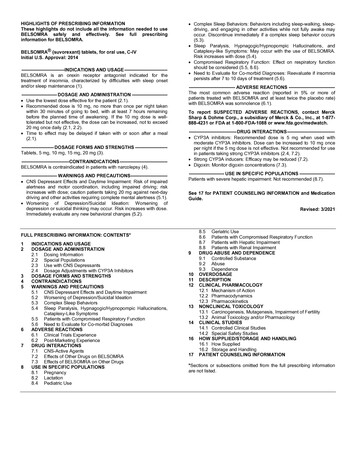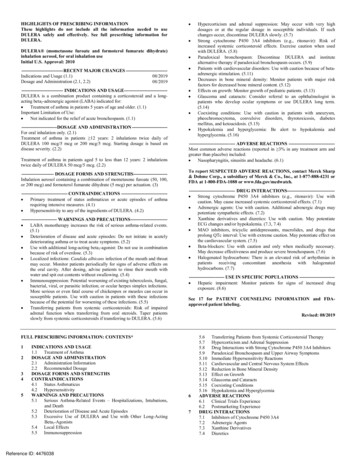
Transcription
HIGHLIGHTS OF PRESCRIBING INFORMATIONThese highlights do not include all the information needed to useDULERA safely and effectively. See full prescribing information forDULERA.DULERA (mometasone furoate and formoterol fumarate dihydrate)inhalation aerosol, for oral inhalation useInitial U.S. Approval: 2010--------------------------- RECENT MAJOR CHANGES --------------------------Indications and Usage (1.1)08/2019Dosage and Administration (2.1, 2.2)08/2019 --------------------------- INDICATIONS AND USAGE ---------------------------DULERA is a combination product containing a corticosteroid and a longacting beta2-adrenergic agonist (LABA) indicated for: Treatment of asthma in patients 5 years of age and older. (1.1)Important Limitation of Use: Not indicated for the relief of acute bronchospasm. (1.1) ----------------------- DOSAGE AND ADMINISTRATION ----------------------For oral inhalation only. (2.1)Treatment of asthma in patients 12 years: 2 inhalations twice daily ofDULERA 100 mcg/5 mcg or 200 mcg/5 mcg. Starting dosage is based ondisease severity. (2.2) Treatment of asthma in patients aged 5 to less than 12 years: 2 inhalationstwice daily of DULERA 50 mcg/5 mcg. (2.2)--------------------- DOSAGE FORMS AND STRENGTHS---------------------Inhalation aerosol containing a combination of mometasone furoate (50, 100,or 200 mcg) and formoterol fumarate dihydrate (5 mcg) per actuation. (3)------------------------------ CONTRAINDICATIONS ----------------------------- Primary treatment of status asthmaticus or acute episodes of asthmarequiring intensive measures. (4.1) Hypersensitivity to any of the ingredients of DULERA. (4.2)----------------------- WARNINGS AND PRECAUTIONS----------------------- LABA monotherapy increases the risk of serious asthma-related events.(5.1) Deterioration of disease and acute episodes: Do not initiate in acutelydeteriorating asthma or to treat acute symptoms. (5.2) Use with additional long-acting beta2-agonist: Do not use in combinationbecause of risk of overdose. (5.3) Localized infections: Candida albicans infection of the mouth and throatmay occur. Monitor patients periodically for signs of adverse effects onthe oral cavity. After dosing, advise patients to rinse their mouth withwater and spit out contents without swallowing. (5.4) Immunosuppression: Potential worsening of existing tuberculosis, fungal,bacterial, viral, or parasitic infection; or ocular herpes simplex infections.More serious or even fatal course of chickenpox or measles can occur insusceptible patients. Use with caution in patients with these infectionsbecause of the potential for worsening of these infections. (5.5) Transferring patients from systemic corticosteroids: Risk of impairedadrenal function when transferring from oral steroids. Taper patientsslowly from systemic corticosteroids if transferring to DULERA. (5.6) ------------------------------ ADVERSE REACTIONS -----------------------------Most common adverse reactions (reported in 3% in any treatment arm andgreater than placebo) included: Nasopharyngitis, sinusitis and headache. (6.1)To report SUSPECTED ADVERSE REACTIONS, contact Merck Sharp& Dohme Corp., a subsidiary of Merck & Co., Inc., at 1-877-888-4231 orFDA at 1-800-FDA-1088 or - DRUG INTERACTIONS------------------------------ Strong cytochrome P450 3A4 inhibitors (e.g., ritonavir): Use withcaution. May cause increased systemic corticosteroid effects. (7.1) Adrenergic agents: Use with caution. Additional adrenergic drugs maypotentiate sympathetic effects. (7.2) Xanthine derivatives and diuretics: Use with caution. May potentiateECG changes and/or hypokalemia. (7.3, 7.4) MAO inhibitors, tricyclic antidepressants, macrolides, and drugs thatprolong QTc interval: Use with extreme caution. May potentiate effect onthe cardiovascular system. (7.5) Beta-blockers: Use with caution and only when medically necessary.May decrease effectiveness and produce severe bronchospasm. (7.6) Halogenated hydrocarbons: There is an elevated risk of arrhythmias inpatients receiving concomitant anesthesia with halogenatedhydrocarbons. (7.7)----------------------- USE IN SPECIFIC POPULATIONS ---------------------- Hepatic impairment: Monitor patients for signs of increased drugexposure. (8.6)See 17 for PATIENT COUNSELING INFORMATION and FDAapproved patient labeling.Revised: 08/2019FULL PRESCRIBING INFORMATION: CONTENTS*12345INDICATIONS AND USAGE1.1 Treatment of AsthmaDOSAGE AND ADMINISTRATION2.1 Administration Information2.2 Recommended DosageDOSAGE FORMS AND STRENGTHSCONTRAINDICATIONS4.1 Status Asthmaticus4.2 HypersensitivityWARNINGS AND PRECAUTIONS5.1 Serious Asthma-Related Events – Hospitalizations, Intubations,and Death5.2 Deterioration of Disease and Acute Episodes5.3 Excessive Use of DULERA and Use with Other Long-ActingBeta2-Agonists5.4 Local Effects5.5 ImmunosuppressionReference ID: 4476038Hypercorticism and adrenal suppression: May occur with very highdosages or at the regular dosage in susceptible individuals. If suchchanges occur, discontinue DULERA slowly. (5.7)Strong cytochrome P450 3A4 inhibitors (e.g., ritonavir): Risk ofincreased systemic corticosteroid effects. Exercise caution when usedwith DULERA. (5.8)Paradoxical bronchospasm: Discontinue DULERA and institutealternative therapy if paradoxical bronchospasm occurs. (5.9)Patients with cardiovascular disorders: Use with caution because of beta adrenergic stimulation. (5.11)Decreases in bone mineral density: Monitor patients with major riskfactors for decreased bone mineral content. (5.12)Effects on growth: Monitor growth of pediatric patients. (5.13)Glaucoma and cataracts: Consider referral to an ophthalmologist inpatients who develop ocular symptoms or use DULERA long term.(5.14)Coexisting conditions: Use with caution in patients with aneurysm,pheochromocytoma, convulsive disorders, thyrotoxicosis, diabetesmellitus, and ketoacidosis. (5.15)Hypokalemia and hyperglycemia: Be alert to hypokalemia andhyperglycemia. (5.16)675.6 Transferring Patients from Systemic Corticosteroid Therapy5.7 Hypercorticism and Adrenal Suppression5.8 Drug Interactions with Strong Cytochrome P450 3A4 Inhibitors5.9 Paradoxical Bronchospasm and Upper Airway Symptoms5.10 Immediate Hypersensitivity Reactions5.11 Cardiovascular and Central Nervous System Effects5.12 Reduction in Bone Mineral Density5.13 Effect on Growth5.14 Glaucoma and Cataracts5.15 Coexisting Conditions5.16 Hypokalemia and HyperglycemiaADVERSE REACTIONS6.1 Clinical Trials Experience6.2 Postmarketing ExperienceDRUG INTERACTIONS7.1 Inhibitors of Cytochrome P450 3A47.2 Adrenergic Agents7.3 Xanthine Derivatives7.4 Diuretics
7.58101112Monoamine Oxidase Inhibitors, Tricyclic Antidepressants, andDrugs Known to Prolong the QTc Interval7.6 Beta-Adrenergic Receptor Antagonists7.7 Halogenated HydrocarbonsUSE IN SPECIFIC POPULATIONS8.1 Pregnancy8.2 Lactation8.4 Pediatric Use8.5 Geriatric Use8.6 Hepatic ImpairmentOVERDOSAGE10.1 Signs and Symptoms10.2 TreatmentDESCRIPTIONCLINICAL PHARMACOLOGY1314161712.1 Mechanism of Action12.2 Pharmacodynamics12.3 PharmacokineticsNONCLINICAL TOXICOLOGY13.1 Carcinogenesis, Mutagenesis, Impairment of Fertility13.2 Animal Toxicology and/or PharmacologyCLINICAL STUDIES14.1 AsthmaHOW SUPPLIED/STORAGE AND HANDLING16.1 How Supplied16.2 Storage and HandlingPATIENT COUNSELING INFORMATION*Sections or subsections omitted from the full prescribing information are notlisted.FULL PRESCRIBING INFORMATION1INDICATIONS AND USAGE1.1 Treatment of AsthmaDULERA is indicated for the twice-daily treatment of asthma in patients 5 years of age and older. DULERA should be used forpatients not adequately controlled on a long-term asthma-control medication such as an inhaled corticosteroid (ICS) or whose diseasewarrants initiation of treatment with both an ICS and long-acting beta2-adrenergic agonist (LABA).Important Limitation of Use: DULERA is NOT indicated for the relief of acute bronchospasm.2DOSAGE AND ADMINISTRATION2.1 Administration InformationAdminister DULERA as two inhalations twice daily every day (morning and evening) by the orally inhaled route (see PatientInstructions for Use in the Patient Information leaflet). Do not use more than two inhalations twice daily of the prescribed strength ofDULERA as some patients are more likely to experience adverse effects with higher doses of formoterol. If symptoms arise betweendoses, an inhaled short-acting beta2-agonist should be taken for immediate relief. Shake well prior to each inhalation. After each dose,advise patients to rinse their mouth with water and, without swallowing, spit out the contents to help reduce the risk of oropharyngealcandidiasis.Remove the cap from the mouthpiece of the actuator before using DULERA.Prime DULERA before using for the first time by releasing 4 test sprays into the air, away from the face, shaking well before eachspray. In cases where the inhaler has not been used for more than 5 days, prime the inhaler again by releasing 4 test sprays into the air,away from the face, shaking well before each spray.Only use the DULERA canister with the DULERA actuator. Do not use the DULERA actuator with any other inhalation drug product.Do not use actuators from other products with the DULERA canister.2.2 Recommended DosageAdminister DULERA as two inhalations twice daily every day (morning and evening) by the orally inhaled route. Shake well prior toeach inhalation. Individual patients may experience a variable time to onset and degree of symptom relief. If symptoms arise betweendoses, use an inhaled short-acting beta2-agonist for immediate relief. Improvement in lung function following administration ofDULERA can occur within 5 minutes of treatment, although the maximum benefit may not be achieved for 1 week or longer afterbeginning treatment.Adult and Adolescent Patients Aged 12 Years and OlderFor patients 12 years and older, the dosage is either 2 inhalations twice daily of DULERA 100 mcg/5 mcg or DULERA 200 mcg/5mcg. When choosing the starting dosage strength of DULERA, consider the patients’ disease severity, based on their previous asthmatherapy, including the inhaled corticosteroid dosage, as well as the patients’ current control of asthma symptoms and risk of futureexacerbation. For patients who do not respond adequately after 2 weeks of therapy with two inhalations of DULERA 100 mcg/5 mcgtwice daily (morning and evening), increasing the dosage to two inhalations of DULERA 200 mcg/5 mcg twice daily (morning andevening) may provide additional asthma control. The maximum recommended dosage is two inhalations of DULERA 200 mcg/5 mcgtwice daily (maximum daily dosage 800 mcg/20 mcg).After asthma stability has been achieved, it may be desirable to titrate to the lowest effective dosage to reduce the possibility of sideeffects.2Reference ID: 4476038
If a previously effective dosage regimen of DULERA fails to provide adequate control of asthma, re-evaluate the therapeutic regimenand consider additional therapeutic options, e.g., replacing the current strength of DULERA with a higher strength, adding additionalinhaled corticosteroid, or initiating oral corticosteroids.Pediatric Patients Aged 5 to Less Than 12 YearsFor patients aged 5 to less than 12 years, the dosage is 2 inhalations of DULERA 50 mcg/5 mcg twice daily. The maximum dailydosage is 200 mcg/20 mcg.3DOSAGE FORMS AND STRENGTHSDULERA is a pressurized metered dose inhaler (MDI) that is available in 2 strengths (100 mcg/5 mcg or 200 mcg/5 mcg) for adultand adolescent patients aged 12 and older and 1 strength (50 mcg/5 mcg) for pediatric patients aged 5 to less than 12 years.DULERA 50 mcg/5 mcg delivers 50 mcg of mometasone furoate and 5 mcg of formoterol fumarate dihydrate per actuation.DULERA 100 mcg/5 mcg delivers 100 mcg of mometasone furoate and 5 mcg of formoterol fumarate dihydrate per actuation.DULERA 200 mcg/5 mcg delivers 200 mcg of mometasone furoate and 5 mcg of formoterol fumarate dihydrate per actuation.Each strength of DULERA is supplied with a blue colored actuator and green dust cap [see How Supplied/Storage and Handling(16.1)].4CONTRAINDICATIONS4.1 Status AsthmaticusDULERA is contraindicated in the primary treatment of status asthmaticus or other acute episodes of asthma where intensivemeasures are required.4.2 HypersensitivityDULERA is contraindicated in patients with known hypersensitivity to mometasone furoate, formoterol fumarate, or any of theingredients in DULERA [see Warnings and Precautions (5.10)].5WARNINGS AND PRECAUTIONS5.1 Serious Asthma-Related Events – Hospitalizations, Intubations, and DeathUse of LABA as monotherapy (without ICS) for asthma is associated with an increased risk of asthma-related death [see SalmeterolMulticenter Asthma Research Trial (SMART)]. Available data from controlled clinical trials also suggest that use of LABA asmonotherapy increases the risk of asthma-related hospitalization in pediatric and adolescent patients. These findings are considered aclass effect of LABA monotherapy. When LABA are used in fixed-dose combination with ICS, data from large clinical trials do notshow a significant increase in the risk of serious asthma-related events (hospitalizations, intubations, death) compared to ICS alone[see Serious Asthma-Related Events with ICS/LABA].Serious Asthma-Related Events with ICS/LABAFour large, 26-week, randomized, blinded, active-controlled clinical safety trials were conducted to evaluate the risk of seriousasthma-related events when LABA were used in fixed-dose combination with ICS compared to ICS alone in patients with asthma.Three trials included adult and adolescent patients aged 12 years: one trial compared mometasone furoate/formoterol (DULERA) tomometasone furoate [see Clinical Studies (14.1)]; one trial compared fluticasone propionate/salmeterol inhalation powder tofluticasone propionate inhalation powder; and one trial compared budesonide/formoterol to budesonide. The fourth trial includedpediatric patients 4 to 11 years of age and compared fluticasone propionate/salmeterol inhalation powder to fluticasone propionateinhalation powder. The primary safety endpoint for all four trials was serious asthma-related events (hospitalizations, intubations anddeath). A blinded adjudication committee determined whether events were asthma-related.The three adult and adolescent trials were designed to rule out a risk margin of 2.0, and the pediatric trial was designed to rule out arisk of 2.7. Each individual trial met its pre-specified objective and demonstrated non-inferiority of ICS/LABA to ICS alone. A metaanalysis of the three adult and adolescent trials did not show a significant increase in risk of a serious asthma-related event withICS/LABA fixed-dose combination compared with ICS alone (Table 1). These trials were not designed to rule out all risk for seriousasthma-related events with ICS/LABA compared with ICS.Table 1: Meta-Analysis of Serious Asthma-Related Events in Patients with Asthma Aged 12 Years and Older3Reference ID: 4476038
ICS/LABA(N 17,537)*11621115ICS(N 17,552)*10502105ICS/LABA vs. ICSHazard ratio (95% CI)†1.10 (0.85, 1.44)Serious asthma-related event‡Asthma-related deathAsthma-related intubation (endotracheal)Asthma-related hospitalization ( 24 hourstay)ICS Inhaled Corticosteroid, LABA Long-acting Beta2-adrenergic Agonist.* Randomized patients who had taken at least 1 dose of study drug. Planned treatment used for analysis.†Estimated using a Cox proportional hazards model for time to first event with baseline hazards stratified by each of the 3 trials.‡Number of patients with events that occurred within 6 months after the first use of study drug or 7 days after the last date of studydrug, whichever date was later. Patients can have one or more events, but only the first event was counted for analysis. A single,blinded, independent adjudication committee determined whether events were asthma-related.The pediatric safety trial included 6208 pediatric patients 4 to 11 years of age who received ICS/LABA (fluticasonepropionate/salmeterol inhalation powder) or ICS (fluticasone propionate inhalation powder). In this trial, 27/3107 (0.9%) patientsrandomized to ICS/LABA and 21/3101 (0.7%) patients randomized to ICS experienced a serious asthma-related event. There were noasthma-related deaths or intubations. ICS/LABA did not show a significantly increased risk of a serious asthma-related eventcompared to ICS based on the pre-specified risk margin (2.7), with an estimated hazard ratio of time to first event of 1.29 (95% CI:0.73, 2.27).Salmeterol Multicenter Asthma Research Trial (SMART)A 28-week, placebo-controlled U.S. trial that compared the safety of salmeterol with placebo, each added to usual asthma therapy,showed an increase in asthma-related deaths in patients receiving salmeterol (13/13,176 in patients treated with salmeterol vs.3/13,179 in patients treated with placebo; relative risk: 4.37 [95% CI: 1.25, 15.34]). Use of background ICS was not required inSMART. The increased risk of asthma-related death is considered a class effect of LABA monotherapy.Formoterol Monotherapy StudiesClinical studies with formoterol used as monotherapy suggested a higher incidence of serious asthma exacerbation in patients whoreceived formoterol than in those who received placebo. The sizes of these studies were not adequate to precisely quantify thedifference in serious asthma exacerbations between treatment groups.5.2 Deterioration of Disease and Acute EpisodesDULERA should not be initiated in patients during rapidly deteriorating or potentially life-threatening episodes of asthma. DULERAhas not been studied in patients with acutely deteriorating asthma. The initiation of DULERA in this setting is not appropriate.Increasing use of inhaled, short-acting beta2-agonists is a marker of deteriorating asthma. In this situation, the patient requiresimmediate re-evaluation with reassessment of the treatment regimen, giving special consideration to the possible need for replacingthe current strength of DULERA with a higher strength, adding additional inhaled corticosteroid, or initiating systemic corticosteroids.Patients should not use more than 2 inhalations twice daily (morning and evening) of DULERA.DULERA is not indicated for the relief of acute symptoms, i.e., as rescue therapy for the treatment of acute episodes of bronchospasm.An inhaled, short-acting beta2-agonist, not DULERA, should be used to relieve acute symptoms such as shortness of breath.When beginning treatment with DULERA, patients who have been taking oral or inhaled, short-acting beta2-agonists on a regularbasis (e.g., 4 times a day) should be instructed to discontinue the regular use of these drugs.5.3 Excessive Use of DULERA and Use with Other Long-Acting Beta2-AgonistsAs with other inhaled drugs containing beta2-adrenergic agents, DULERA should not be used more often than recommended, at higherdoses than recommended, or in conjunction with other medications containing long-acting beta2-agonists, as an overdose may result.Clinically significant cardiovascular effects and fatalities have been reported in association with excessive use of inhaledsympathomimetic drugs. Patients using DULERA should not use an additional long-acting beta2-agonist (e.g., salmeterol, formoterolfumarate, arformoterol tartrate) for any reason, including prevention of exercise-induced bronchospasm (EIB) or the treatment ofasthma.5.4 Local EffectsIn clinical trials, the development of localized infections of the mouth and pharynx with Candida albicans have occurred in patientstreated with DULERA. If oropharyngeal candidiasis develops, treat with appropriate local or systemic (i.e., oral) antifungal therapywhile remaining on treatment with DULERA therapy, but at times therapy with DULERA may need to be interrupted. To reduce therisk of oropharyngeal candidiasis, after dosing with DULERA, advise patients to rinse their mouth with wate
DULERA is NOT indicated for the relief of acute bronchospasm. 2 DOSAGE AND ADMINISTRATION . 2.1 . Administration Information . Administer DULERA as two inhalations twice daily every day (morning and evening) by the orally inhal
